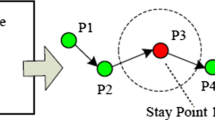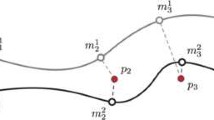Abstract
Geolocation is a powerful source of information through which user patterns can be extracted. User regions-of-interest, along with these patterns, can be used to recognize and imitate user behavior. In this work we develop a methodology for preprocessing location data in order to discover the most relevant places the user visits, and we propose a Probabilistic Finite Automaton structure as mobility model. We analyse both location prediction and user identification tasks. Our model is assessed with two evaluation metrics regarding its predictive accuracy and user identification accuracy, and compared against other models.






Similar content being viewed by others
References
Amirat H, Benslimane A, Fournier-Viger P, Lagraa N (2018) Locrec: Rule-based successive location recommendation in lbsn. In: 2018 IEEE International Conference on Communications (ICC), pp 1–6
Argall BD, Chernova S, Veloso M, Browning B (2009) A survey of robot learning from demonstration. Robot Auton Syst 57(5):469–483
Batabyal S, Bhaumik P (2015) Mobility models, traces and impact of mobility on opportunistic routing algorithms: a survey. IEEE Commun Surv Tutor 17(3):1679–1707
Billard A, Calinon S, Dillmann R, Schaal S (2008) Robot programming by demonstration. Springer, Berlin, Heidelberg, pp 1371–1394
Bishop CM, Lasserre J (2007) Generative or discrimative? Getting the best of both worlds. Oxford University Press, Oxford, pp 3–24
Cook DJ, Augusto JC, Jakkula VR (2009) Ambient intelligence: technologies, applications, and opportunities. Pervasive Mob Comput 5(4):277–298
Dereszynski E, Hostetler J, Fern A, Dietterich T, Hoang TT, Udarbe M (2011) Learning probabilistic behavior models in real-time strategy games. In: Proceedings of the seventh AAAI conference on artificial intelligence and interactive digital entertainment, AAAI Press, AIIDE’11, pp 20–25
Do TMT, Dousse O, Miettinen M, Gatica-Perez D (2015) A probabilistic kernel method for human mobility prediction with smartphones. Pervasive Mob Comput 20(C):13–28
Duan Y, Andrychowicz M, Stadie B, Jonathan Ho O, Schneider J, Sutskever I, Abbeel P, Zaremba W (2017) One-shot imitation learning. In: Advances in neural information processing systems 30, Curran Associates, Inc., pp 1087–1098
Ester M, Kriegel HP, Sander J, Xu X (1996) A density-based algorithm for discovering clusters a density-based algorithm for discovering clusters in large spatial databases with noise. In: Proceedings of the second international conference on knowledge discovery and data mining, AAAI Press, KDD’96, pp 226–231
Feng Z, Zhu Y (2016) A survey on trajectory data mining: techniques and applications. IEEE Access 4:2056–2067
Gambs S, Killijian MO, del Prado Cortez MNN (2012) Next place prediction using mobility markov chains. In: Proceedings of the first workshop on measurement, privacy, and mobility, ACM, New York, NY, USA, MPM ’12, pp 3:1–3:6
Giannotti F, Nanni M, Pinelli F, Pedreschi D (2007) Trajectory pattern mining. In: Proceedings of the 13th ACM SIGKDD international conference on knowledge discovery and data mining, ACM, New York, NY, USA, KDD ’07, pp 330–339
González M, Hidalgo C, Barabási a L (2008) Understanding individual human mobility patterns. Nature 453(June):779–782
Jahromi KK, Zignani M, Gaito S, Rossi GP (2016) Simulating human mobility patterns in urban areas. Simul Model Pract Theory 62:137–156
Jiang S, Ferreira J, Gonzalez MC (2017) Activity-based human mobility patterns inferred from mobile phone data: a case study of singapore. IEEE Trans Big Data 3(2):208–219
Li Q, Zheng Y, Xie X, Chen Y, Liu W, Ma WY (2008) Mining user similarity based on location history. In: Proceedings of the 16th ACM SIGSPATIAL international conference on advances in geographic information systems, ACM, New York, NY, USA, GIS ’08, pp 34:1–34:10
Lin M, Hsu WJ (2014) Mining gps data for mobility patterns: a survey. Pervasive Mob Comput 12:1–16
Liu Q, Wu S, Wang L, Tan T (2016) Predicting the next location: a recurrent model with spatial and temporal contexts. In: Proceedings of the Thirtieth AAAI conference on artificial intelligence, AAAI Press, AAAI’16, pp 194–200
Lu X, Wetter E, Bharti N, Tatem AJ, Bengtsson L (2013) Approaching the limit of predictability in human mobility. Sci Rep 3:2923
Lv Q, Qiao Y, Ansari N, Liu J, Yang J (2017) Big data driven hidden markov model based individual mobility prediction at points of interest. IEEE Trans Veh Technol 66(6):5204–5216
Munjal A, Camp T, Aschenbruck N (2012) Changing trends in modeling mobility. J Electric Comput Eng 2012:372572:1–372572:16
Ontañón S, Mishra K, Sugandh N, Ram A (2008) Learning from demonstration and case-based planning for real-time strategy games. In: Prasad B (eds) Soft computing applications in industry. Studies in fuzziness and soft computing, vol 226. Springer, Berlin, Heidelberg
Ontañón S, Montaña JL, Gonzalez AJ (2014) A dynamic-bayesian network framework for modeling and evaluating learning from observation. Expert Syst Appl 41(11):5212–5226
Pomerleau DA (1989) Alvinn: an autonomous land vehicle in a neural network. Adv Neural Inf Process Syst 1:305–313
Rios JDMY, Banks J, Cavendish H (1797) Recherches sur les principaux problemes de l’astronomie nautique. Par Don Josef de Mendoza y Rios, F. R. S. Communicated by Sir Joseph Banks, Bart. K. B. P. R. S. Philos Trans Royal Soc London Series I 87:43–122
Roxin A, Gaber J, Wack M, Nait-Sidi-Moh A (2007) Survey of wireless geolocation techniques. In: 2007 IEEE Globecom Workshops, pp 1–9
Salomón S, Tîrnăucă C, Duque R, Montaña JL (2017) Daily routines inference based on location history. In: Ubiquitous computing and ambient intelligence. Springer International Publishing, Cham, pp 828–839
Tîrnăucă C, Montaña JL, Ontañón S, González AJ, Pardo LM (2016) Behavioral modeling based on probabilistic finite automata: an empirical study. Sensors 16(7):958
Zheng Y (2015) Trajectory data mining: an overview. ACM Trans Intell Syst Technol 6(3):29:1–29:41
Zheng Y, Chen Y, Xie X, Ma WY (2009) Geolife2.0: A location-based social networking service. In: 2009 tenth international conference on mobile data management: systems, services and middleware, pp 357–358
Acknowledgements
The authors gratefully acknowledge the financial support from FEDER (Fondo Europeo de Desarrollo Regional) and SODERCAN (Sociedad para el Desarrollo Regional de Cantabria) for the project TI16-IN-007 within the program “I+C=+C 2016—PROYECTOS DE I+D EN EL ÁMBITO DE LAS TIC, LÍNEA SMART”, and from Ministerio de Ciencia e Innovación (MICINN), Spain for the project PAC::LFO (MTM2014-55262-P).
Author information
Authors and Affiliations
Corresponding author
Additional information
Publisher's Note
Springer Nature remains neutral with regard to jurisdictional claims in published maps and institutional affiliations.
Rights and permissions
About this article
Cite this article
Salomón, S., Tîrnăucă, C., Duque, R. et al. User identification from mobility traces. J Ambient Intell Human Comput 14, 31–40 (2023). https://doi.org/10.1007/s12652-018-1117-4
Received:
Accepted:
Published:
Issue Date:
DOI: https://doi.org/10.1007/s12652-018-1117-4




